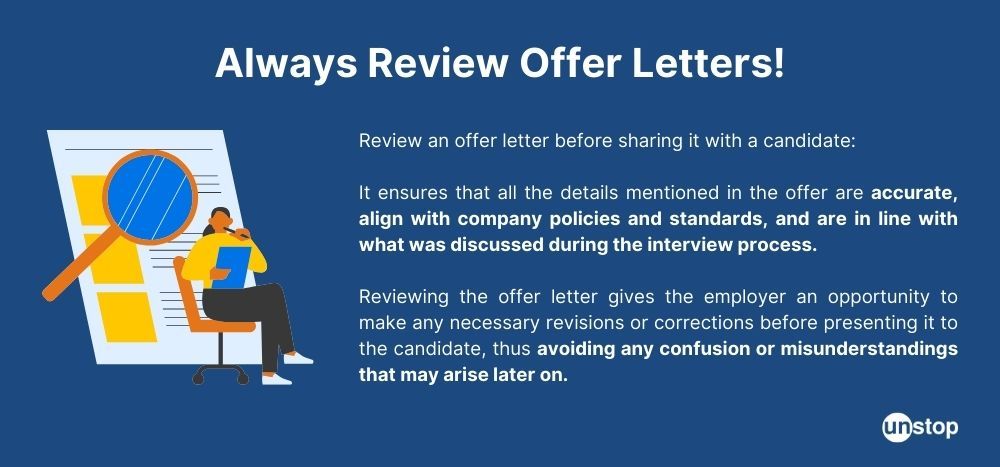- What is an Offer Letter?
- Importance in the Hiring Process
- Components of an Offer Letter
- What is an Offer Letter Format?
- Differences Between an Offer Letter and a Contract
- Types of Offer Letters
- Job Offer Letter Sample
- Common Mistakes to Avoid in an Offer Letter
- Final Remarks
- Frequently Asked Questions
What Is An Offer Letter? Get Definition, Components & Samples

An offer letter is a crucial document in the job hiring process. It stands apart from a verbal agreement or informal communication. An offer letter outlines the terms of employment, including salary, benefits, and start date. This clarity helps both employers and candidates avoid misunderstandings.
Read ahead to develop a thorough understanding of what is an offer letter, what are its key components, and its importance in the hiring process.
What is an Offer Letter?
Offer Letter Meaning
An offer letter is a formal document from an employer to a candidate that outlines the terms of employment, including the job title, salary, and benefits. A good offer letter provides clarity in the hiring process.
Verbal vs. Written
A verbal job offer is often informal. It may lack important details. In contrast, a written offer letter is official. It includes specific terms that both parties must agree upon.
A job offer letter can be reviewed and referenced later, ensuring everyone understands their responsibilities. Reviewing an offer letter ensures professionalism in the hiring process and can lead to a smoother onboarding experience for both the employer and the candidate.


Importance in the Hiring Process
Formal Relationship
An offer letter formalizes the employment relationship between a potential employee and the employer. It serves as an official document that confirms the job offer. This letter outlines the specific job position, which helps both parties understand their roles.
Clear Expectations
The offer letter sets clear expectations for both the employer and the prospective employee. It details pertinent employment information such as salary, benefits, and work assignments. This clarity helps prevent misunderstandings later in the hiring process. Each party knows what is expected from them.
Candidate Perception
A well-structured offer letter significantly impacts how candidates perceive the company. It reflects professionalism and attention to detail. Candidates often feel valued when they receive a comprehensive document outlining relevant employment terms. This can enhance their enthusiasm about joining the team and boost the overall employer brand.
Components of an Offer Letter

Important components of an offer letter include:
- Job title and description: A job title and description typically outline the specific role and responsibilities of the position. This helps potential candidates understand what the job entails and if it aligns with their skills and interests.
- Compensation Package: The compensation package outlines salary and benefits. This section details the salary package, including bonuses, health insurance, and retirement plans. It may mention the salary and payment schedule details, i.e., when employees can expect to receive their payments and additional perks or advantages that come with the job, such as professional development opportunities.
- Start Date & Time: The start date indicates when the successful candidate is expected to begin working in the position. This information is important for both the employer and the candidate to plan accordingly and ensure a smooth transition into the new role. The offer letter usually also mentions the reporting time.
- Other Basic Information: This includes information about the employment type (full-time, part-time, contract), reporting structure (who the employee will report to), probationary period (if applicable), work schedule (hours, days) and acceptance deadline.
- Additional Components: Offer letters include additional components. These may be signing bonuses, relocation assistance, or stock options. Non-compete clauses can also appear, restricting employment with competitors after leaving the company.
Remember, the specific content of an offer letter may vary depending on the company, industry, and the specific job role. It's essential to ensure that the offer letter is clear, concise, and legally compliant.
Importance of Acceptance Deadlines in Offer Letters
Specifying acceptance deadlines ensures that the hiring process moves forward efficiently and allows the company to make necessary arrangements once the candidate accepts the offer.
Typically, companies give candidates one to two weeks to accept or reject an offer letter. This timeframe allows candidates enough time to carefully review the offer, consider any potential counteroffers, and make an informed decision without causing unnecessary delays in the hiring process.
Setting a reasonable acceptance deadline also shows respect for the candidate's time and demonstrates professionalism on the part of the company.
What is an offer letter?
An offer letter, or offer of employment, is a document that outlines the work arrangements and expectations sent to a job candidate before they become an employee.
When is an offer letter sent?
An employer usually sends an offer letter to a potential employee during the hiring process once they have accepted the job via email or phone.
After the employee receives the offer letter, they should sign their signature indicating that they agree with the terms and formally accept the position. Most offer letters are also reviewed and signed by the hiring manager or a senior member of the company.
What should you include in an offer letter: Offer letter format
An offer letter typically follows a formal business letter format. Here's a basic structure:
Header
- Company Letterhead
- Date
Salutation
-
Dear [Candidate's Name],
Introduction
- Expresses congratulations on being selected for the position
- Outlines the job title and department
Job Details
- Clearly states the job title and department
- Specifies the start date and location
- Outlines the job responsibilities and reporting structure
- Details the employment type (full-time, part-time, contract)
- Mentions the probationary period (if applicable)
Compensation and Benefits
- Clearly states the salary or hourly wage
- Outlines the benefits package (health insurance, paid time off, etc.)
- Mentions any additional perks or allowances
Terms and Conditions
- Specifies the employment terms (at-will, contract, etc.)
- Outlines the work schedule
- Mentions any confidentiality or non-compete agreements
- Includes information about background checks or drug tests (if required)
Acceptance and Confirmation
- Specifies the deadline for accepting the offer
- Includes contact information for questions or clarifications
- Requests a signed copy of the offer letter as acceptance
Closing
- Thank the candidate for considering the job offer
- Expresses enthusiasm for the candidate joining the team
Signature
- Employer's name and title
- Company name
Remember:
- Use clear and concise language.
- Avoid jargon or technical terms.
- Proofread carefully for errors.
- Keep a copy of the offer letter for your records.
Differences Between an Offer Letter and a Contract
An offer letter is different from a contract. Here’s how:
| Aspect | Offer Letter | Contract |
|---|---|---|
| Definition Clarity | An offer letter is a document that outlines the terms of employment. It usually includes job title, salary, and start date. | A contract is a legally binding agreement. It covers more detailed obligations and rights for both parties. |
| Legality | An offer letter may not always be legally binding. It can serve as a formal invitation to join the company. | Creates enforceable obligations. Once signed, both parties must follow the terms set in the contract. |
| Content Depth | Brief, focusing on key details like compensation and benefits | Extensive clauses covering various scenarios |
| Acceptance Process | Most companies expect candidates to sign an offer letter quickly. This shows acceptance of the job offer. | Often requires negotiation before signing. Both parties may discuss specific terms before finalizing the contract. |
| Revocation Possibility | Employers can revoke before signing | Complicated to revoke once signed, legal consequences possible |
Types of Offer Letters
Standard
A basic offer letter includes essential details. It should start with the job title, salary, and start date and include the company name and address at the top. It should also clearly state that this is an offer of employment.
Next, outline key responsibilities. Mention any conditions for acceptance, such as background checks. Also, specify benefits like health insurance or vacation days.
To add more structure:
Begin with a professional greeting. Use the candidate's full name and address. State the position clearly and mention the reporting manager. Include compensation details in a separate section. Outline bonuses or stock options if applicable. Add a paragraph about company culture or values to engage the candidate.
Remember: A verbal confirmation of the role is treated as an informal offer.
Conditional Offer
A conditional offer template specifies requirements before employment starts. List conditions like drug tests or reference checks. Clearly explain that the offer is contingent upon meeting these conditions.
Highlight important dates for responses. Set deadlines for accepting or declining the offer. Provide contact information for questions.
Follow-Up Offer
A follow-up template reminds candidates about their decision. It can restate key points from the original offer letter, include a polite reminder of the response deadline, and, in specific cases, include a counteroffer.
Consider adding a personal touch by referencing previous conversations. This can help maintain a positive relationship even if they choose another opportunity.
Job Offer Letter Sample
Sample Offer Letter: Standard
Company Logo
[Date]
[Candidate Name] [Candidate Address]
Dear [Candidate Name],
We are pleased to offer you the position of [Job Title] at [Company Name], effective [Start Date]. Your role will involve [brief job description]. You will report to [Supervisor’s Name], [Supervisor’s Title].
Your annual base salary for this position will be [Salary Amount]. Your benefits package will include [list of benefits, e.g., health insurance, paid time off, etc.]. A detailed benefits package will be provided to you upon your start date.
Your employment with [Company Name] is considered at-will, meaning either you or the company may terminate the employment relationship at any time, with or without cause or notice.
We look forward to having you join our team. Please sign and date the enclosed copy of this letter and return it to us by [Date].
Sincerely,
[Your Name]
[Your Title]
[Company Name]
Sample Offer Letter: Conditional
Company Logo
[Date]
[Candidate Name] [Candidate Address]
Dear [Candidate Name],
We are pleased to offer you the position of [Job Title] at [Company Name], contingent upon the successful completion of the following conditions:
- Satisfactory completion of a background check
- Successful completion of a pre-employment drug test
Assuming you meet the above conditions, your employment will commence on [Start Date]. Your role will involve [brief job description]. You will report to [Supervisor’s Name], [Supervisor’s Title].
Your annual base salary for this position will be [Salary Amount]. Your benefits package will include [list of benefits, e.g., health insurance, paid time off, etc.]. A detailed benefits package will be provided to you upon your start date.
Your employment with [Company Name] is considered at-will, meaning either you or the company may terminate the employment relationship at any time, with or without cause or notice.
We will contact you within [number] business days to inform you of the results of the background check and drug test.
Please sign and date the enclosed copy of this letter and return it to us by [Date].
Sincerely,
[Your Name]
[Your Title]
[Company Name]
Note: This is a basic template and may require modifications based on specific company policies, legal requirements, and the nature of the position. It's advisable to consult with legal counsel to ensure compliance with all applicable laws and regulations.
Common Mistakes to Avoid in an Offer Letter
Missing Details
Offer letters need to include all necessary information. This includes job title, salary, and start date. Omitting any of these details can lead to confusion. Candidates may misunderstand their role or compensation. Clarity is crucial for both parties.
Ambiguous Language
Using unclear language creates problems. Phrases like “competitive salary” do not specify amounts. Candidates appreciate precise figures. Clear terms help avoid misunderstandings later on.
Incorrect Dates
Offer letters must include accurate start dates. An incorrect start date can disrupt a candidate’s plans and may also reflect poorly on the organization. Always double-check the dates before sending the letter.
Lack of Conditions
Conditions of employment should be clearly stated. These might include background checks or drug tests. If candidates are unaware of these conditions, it can lead to issues down the line. Transparency builds trust between employers and candidates.
Not Including Benefits
Benefits play a vital role in job offers. Failing to mention health insurance or retirement plans can make an offer less attractive. Candidates often weigh benefits heavily when considering a position.
Ignoring Company Policies
It is essential to include company policies, which cover topics like dress code and remote work options. Candidates should know what is expected of them.
Final Remarks
Understanding what an offer letter is and its role in the hiring process is crucial for both employers and candidates. You’ve learned about its components, legal implications, and how it differs from a contract. Avoiding common mistakes can save you time and headaches down the line.
Whether you’re drafting or reviewing an offer letter, ensure it’s clear, comprehensive, and professional. This will not only reflect well on your organization but also set the stage for a positive relationship with new hires.
Frequently Asked Questions
1. Is offer letter legally binding?
Offer letters are generally not legally binding contracts, but they can become binding if they include specific terms of employment and are accepted by the candidate.
2. How does an offer letter differ from a contract?
An offer letter outlines job specifics but doesn’t typically include all legal obligations found in a contract. A contract is more detailed and legally enforceable.
3. Are there common mistakes to avoid in an offer letter?
Yes, common mistakes include vague language, missing key details, or failing to specify contingencies like background checks. Clarity is crucial for avoiding misunderstandings.
4. What should be included in an offer letter?
An offer letter typically includes the job title, start date, salary, benefits, working hours, reporting structure, employment type (full-time, part-time, contract), conditions of employment, and any contingencies (like background checks or drug tests). It may also outline the terms of at-will employment, confidentiality agreements, and other relevant policies.
5. How long should a candidate have to respond to an offer letter?
The standard response time is usually between 3 to 7 days. This allows the candidate enough time to consider the offer while ensuring the hiring process moves forward efficiently.
6. What happens if a candidate accepts an offer but later declines it?
If a candidate accepts an offer and then declines, it’s generally considered a withdrawal of acceptance. The employer may choose to move on to another candidate or restart the hiring process. Depending on the timing, it could cause delays and may necessitate revisiting other candidates.
6. Should an offer letter include a deadline for acceptance?
Yes, including a deadline helps keep the hiring process on track. It also clarifies the timeline for the candidate and prevents indefinite delays in filling the position.
7. Can an offer letter be rescinded?
Yes, an offer letter can be rescinded before the candidate accepts it, especially if there are changes in the company’s needs or the candidate fails to meet pre-employment requirements. However, rescinding an offer after acceptance could lead to legal complications, depending on the circumstances.
8. Can you negotiate a job offer letter?
Yes, you can negotiate an employment offer letter. Common areas for negotiation include salary, joining date, job role, benefits, and remote work flexibility. It is best to do so professionally before signing.
Suggested Reads:
- Retaining Freelancers Is An Art. 7 Strategies To Became A Retention Artist
- Job Enlargement: Definition, Benefits, And Implementation Process
- Balancing Dry Promotion With Talent Retention: A Detailed Guide For HRs
- Dealing With Employee Absenteeism Through Effective Strategies
- HR Guide To Employee Sabbatical Leave: Pros, Cons & Key Considerations
I’m a reader first and a writer second, constantly diving into the world of content. If I’m not writing or reading, I like watching movies and dreaming of a life by the beach.
Login to continue reading
And access exclusive content, personalized recommendations, and career-boosting opportunities.
Subscribe
to our newsletter
Blogs you need to hog!

Organize Hackathons: The Ultimate Playbook With Past Case Studies

What is Campus Recruitment? How To Tap The Untapped Talent?

Lateral Hiring: A Complete Guide To The Process, Its Benefits, Challenges & Best Practices













Comments
Add comment